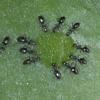First, it seems size for this species varies a lot. The ones down in San Diego were a lot smaller. And, I'm also not sure...but I think these are a one queen variety and not multiple queens. With that said, the colonies in less than a year grow to a HUGE size with a good 2-3 foot high mound. So, it may be there are more than one productive...I doubt it, however. I went through the mound and only saw that one queen. So, its more likely one queen produces more eggs (or at the very least, the same amount) than even the multiple queened colony did in San Diego. Which, is interesting to me.
As for the size. The best I can describe them for now that most people know, is that the smallest workers are the same size as Dorymyrmex bicolor and the largest majors are nearly the same size as Pogonomyrmex subnitidus (I find this species smaller than some Pogonomyrmex, but still big overall). So, you can imagine very big ants! At least two or three times bigger than the ones down in San Diego were.
Also, for those that read this and have S. invicta near you...in a month or two (3 at most) keep an eye on flights. ![]() This colony had tons of alate brood (none had eclosed yet). Which means flights for them shouldn't be too far away from now.
This colony had tons of alate brood (none had eclosed yet). Which means flights for them shouldn't be too far away from now.
As for the colony. I ended up getting over 5,000 workers. I aimed to get less, but ah well. I got a bunch of alate brood (and probably worker brood too) and the queen herself. The queen still had a wing (just one) on her, but it came off when I put them in the ant setup. I just used two small containers and a tube, just enough room for them. But, I'll probably expand it at some point soon.
If my calculation is right...my last S. invicta queen (who was MUCH smaller) got over 100,000 ants in 6 months. However, the variety here (not just the size) only have one queen a nest and that means they are going to grow a lot faster than my previous S. invicta. Their colonies grow CRAZY fast outside, at a rate that even the 20+ queen colony in San Diego didn't even close to match. It almost makes me think they might be slightly different species and regarded as the same (maybe not, but I know Forelius pruinosus and mccooki are like that. And Dorymyrmex bicolor are many species in one).
In any case...I actually find Solenopsis invicta do really well in formicariums. My last colony (you may have seen the post on here, they were the first ants I ever kept) I used sticks instead of tubes (that was a bad idea). But, now that I use smaller containers with tubes to connect them...it will be a lot easier. The only thing will be the number of ants I'll have as the queen is going to lay eggs SUPER fast. And, actually...they are really hardy too. Hardier than the ones down in San Diego. I went down a month ago to try and get some, but no queen so I poured out the dirt. But, I guess a few workers were stuck to the condensation and a month later (today) the workers were crawling around still. I felt really bad, but they went up to the new workers I put in and they still got along. But, the container was bone dry with not a hint of food...for an entire month. Tells me they'll be good ant farm ants that won't just die off easily.
They are also pretty interesting to watch. They don't move so fast (like Dorymyrmex bicolor) that I can't ever open the lid to feed/clean them...but, they aren't slow either. And, this variety is HUGE compared to any other Solenopsis I've seen. Especially the majors, nearly the same size as the queen.
Edited by Vendayn, March 21 2015 - 9:16 PM.


















